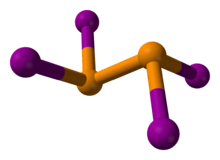Subhalide

In chemistry, subhalide usually refers to inorganic compounds where the halide/metal ratio requires metal-metal (or element-element for nonmetals) bonding, sometimes extensively. Many compounds meet this definition.
Examples
Boron forms many subhalides, starting with B2X4, a representative member being diboron tetrafluoride. Aluminium forms a variety of subhalides. For gallium, adducts of Ga2Cl4 are known. Phosphorus subhalides include P2I4 P4Cl2, and P7Cl3 (structurally related to P73−). For bismuth, the compound originally described as bismuth monochloride was later shown to consists of Bi95+ clusters with chloride anions.[1] Telluriium subhalides are particularly extensive and include the following members Te3Cl2, Te2X (X = Cl, Br, I), and two forms of TeI.[2]
References
- ↑ Greenwood, Norman N.; Earnshaw, Alan (1997). Chemistry of the Elements (2nd ed.). Butterworth-Heinemann. ISBN 0-08-037941-9.
- ↑ Zhengtao Xu "Recent Developments in Binary Halogen–Chalcogen Compounds, Polyanions and Polycations" in Handbook of Chalcogen Chemistry: New Perspectives in Sulfur, Selenium and Tellurium, Francesco Devillanova, Editor, 2006, RSC. pp. 381-416. Royal Society doi:10.1039/9781847557575-00455